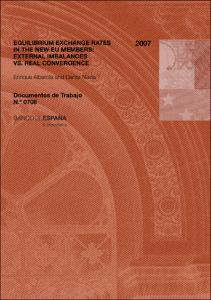Registro completo de metadatos
| Campo DC | Valor |
|---|---|
| dc.contributor.author | Alberola, Enrique |
| dc.contributor.author | Navia Simón, Daniel |
| dc.coverage.spatial | Países de la UE |
| dc.date.accessioned | 2019-08-10T17:50:06Z |
| dc.date.available | 2019-08-10T17:50:06Z |
| dc.date.issued | 2007-06-08 |
| dc.identifier.issn | ISSN: 0213-2710 (en papel) |
| dc.identifier.issn | ISSN: 1579-8666 (en línea) |
| dc.identifier.uri | https://repositorio.bde.es/handle/123456789/6910 |
| dc.description.abstract | New EU members share two very marked features which have conflicting implications for the evolution of their real exchange rates in the long run: accelerated growth and systematic current account imbalances, which would anticipate, respectively an appreciation and a depreciation of their currencies, according to different theories of exchange rate determination. Furthermore, both elements are intertwined, for current account imbalances are the other side of capital inflows which have been central in boosting potential output and productivity convergence in these economies. In this paper, we aim at achieving some insight on the role of persistent and substantial capital inflows and the consequent accumulation of net foreign liabilities in improving competitiveness and in the determination of the exchange rate for the three largest new EU members: Poland, Hungary and the Czech Republic. We adopt a sequential approach that sheds light on the role of capital flows and their interaction with the Balassa-Samuelson hypothesis. We start by noting in a bivariate cointegration analysis that the accumulation of net foreign liabilities, far from depressing the exchange rate in the long-run, has gone hand-in-hand with exchange rate appreciation. We claim that this may be due to the induced effect that capital inflows are expected to have on productivity and competitiveness. After testing that foreign direct investment is cointegrated with productivity trends, we show that a extended empirical model comprising relative productivity and net foreign assets is well-suited in general to capture this indirect, opposite effect of liabilities accumulation on the real exchange rate.. |
| dc.format.extent | 37 p. : gráf. |
| dc.language.iso | en |
| dc.publisher | Banco de España |
| dc.relation.ispartof | Documentos de Trabajo / Banco de España, 0708 |
| dc.rights | Reconocimiento-NoComercial-CompartirIgual 4.0 Internacional (CC BY-NC-SA 4.0) |
| dc.rights | In Copyright - Non Commercial Use Permitted |
| dc.rights.uri | https://creativecommons.org/licenses/by-nc-sa/4.0/deed.es_ES |
| dc.rights.uri | http://rightsstatements.org/vocab/InC-NC/1.0/ |
| dc.subject | New EU members |
| dc.subject | Balassa-Samuelson |
| dc.subject | FDI |
| dc.subject | REER |
| dc.subject | Current account |
| dc.subject | Convergence |
| dc.title | Equilibrium exchange rates in the new EU members : external imbalances vs. real convergence |
| dc.title.alternative | Equilibrium exchange rates in the new EU members : external imbalances versus real convergence |
| dc.type | Documento de trabajo |
| dc.identifier.bdebib | 000190917 |
| dc.identifier.bdepub | DTRA-200708-eng |
| dc.subject.bde | Comercio internacional |
| dc.subject.bde | Finanzas internacionales |
| dc.subject.bde | Integración monetaria europea |
| dc.publisher.bde | Madrid : Banco de España, 2007 |
| dc.subject.jel | F21 |
| dc.subject.jel | F31 |
| dc.subject.jel | F32 |
| dc.subject.jel | F36 |












